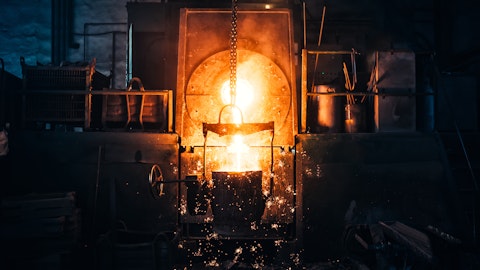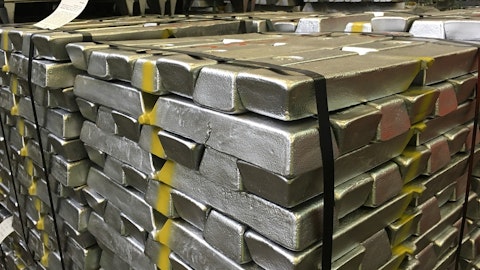Timna Tanners: Okay. So that was helpful with regard to how you’re thinking about the aluminum market and the, obviously, vast amount of capacity additions that you’re looking at. But if you could talk a little bit about why build a new smelter? You note that there hasn’t been one built primary smelter in over 40 years. There’s probably a reason for that. Maybe this is a unique opportunity because of the barriers you mentioned, right, the sanctions and 2-32 tariffs, et cetera. But why not focus more on secondary as a green alternative? And why build versus restart existing?
Jesse Gary: Yes. It’s a good point, Timna. So as you mentioned in your call, there has not been a new smelter built in the U.S. since Mt. Holly was built in 1980. And as you might imagine, there’s been a lot of advancement on the efficiency side over that time period. So we’re ready to build and produce for the long term here in the U.S. We think those existing sites are viable. But what — with the new smelter, we’ll be able to create a cost footprint that should be first quartile globally. And that’s really a game changer for us. And you’re right, putting together some of the near-shoring trends, DOE grant, the 45X tax credits, we think there’s a real opportunity right now to engage in that, and that’s really why we’re looking at that.
Maybe just secondarily, versus secondary — looking at primary versus secondary growth, we think there will be growth in both. There are many applications that do require primary. And so we think that’s a good driver here for the primary smelter. And then there’s also demand growth and additional calls for secondary aluminum and its recycled nature and green credentials. So we think being able to offer our customers both of those things at home here in the U.S. is a really nice initiative and a nice suite of products that will be helpful when we’re making sales to our customers.
Operator: Your final question comes from the line of John Tumazos of John Tumazos Independent Research.
John Tumazos: Jesse, could you give us a little primary in pot lining 101? Does the $10 million do the whole thing in the second quarter? Or will it continue into the third and fourth quarters? When you reline the pots, do you reline them 1 month before you expect them to fail or 1 year before you expect them to fail? And was there a productivity loss in the first quarter delaying the pot line reline or the pots at [indiscernible] output that you lost?
Jesse Gary: Sure, John. Happy to do it and really just to talk about this generally. So as we discussed, we did have a bit of an energy curtailment from one of our suppliers in Iceland in Q1 and falling into Q2. And what you do when you get an energy curtailment like that is you generally will take a small portion of your pots offline equal to basically to reduce your energy consumption. And so that’s what happened in Q1. And as you might imagine, when we choose which pot to take offline, we take the ones that would be due for relining during that quarter anyway. So in Q1, you get a bit of a deferral because you’re not relining pots because you’ve taken them out to meet the energy curtailment. And then as we get ready in Q2 to put those pots back online, you will reline both the pots you would have relined in Q1 and the pots you are planning to reline in Q2, which is what really drives that $10 million headwind that you see there.
So that will be a onetime thing in Q2, will not repeat, and we’ll go back to our normal pot relining process going forward.
John Tumazos: Are there any other expenses that might have been delayed where you’d have a little breathing room now with the metal price rising? For example, [indiscernible] and Ryan or all the engineers working on these projects do for a 10% rate. Are there other cost catch-ups now that things are moving in the right direction?
Jesse Gary: Not really, John. As we go through the cycles, we do try to maintain and run our sustaining CapEx programs on a steady basis. One thing you learned being in this business over long periods of time is while the market is cyclical, you really want to keep these plants operating as stable as possible through the cycles. And so we try not to defer large amounts of that sustaining CapEx over time. So not a whole lot of items that I can think that would fall into that category, should be pretty clean going forward from that perspective.
John Tumazos: I want to complement you on working so hard with the secondary aluminum expansions in the greenfield smelter. The market needs it. And it’s great that you guys burn midnight oil and do all these things.
Jesse Gary: Thanks, John. We really appreciate that.
Operator: As there are no additional questions waiting at this time, I’d like to hand the conference call back over to Jesse Gary for closing remarks.
Jesse Gary: Thanks, everyone, for joining the call today. Just before I end the call, I would just like to take a little bit of time to talk about the recent run-up in LME prices and as Jerry mentioned, how those will impact our outlook going forward. So as Jerry mentioned, if you just adjusted — well, maybe first to start, if people will remember, we do have lags with our customers and as how LME runs through our results and also how regional premiums run through our results. So when you look at that, for our U.S. volumes, we’ve got a 1-month lag for 50% of the volumes and a 3-month lag for 50% of the volumes. And Iceland primarily runs on a 3-month lag. So you do get a little bit of a delay of the benefit of rising LME running through our results.
Similar on the premiums. You have a 1-month lag on Midwest premium, and you’ve got a 3-month lag on the European premium. And you can see all these lags on our financial information that’s on Slide 20 of the slides. And so as Jerry mentioned, if you did just assume for a second that those lags didn’t exist and instead look at the second quarter outlook with spot LMEs, you get a much higher estimated results of somewhere between $75 million and $85 million. And that’s before additional upside opportunities that we have. So for instance, EDPP, if you look at where that is today versus where it is in our Q2 results, it’s about $50 higher. And if you look at regional U.S. Midwest premiums, if you look at the forwards, those are trading $0.04 to $0.05 higher from what they were in Q2.




